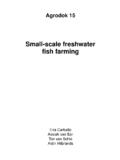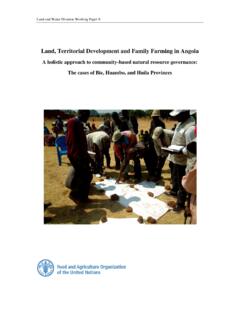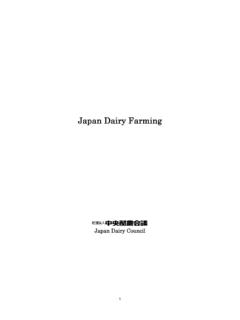Transcription of TOWARDS - Beecham Research
1 TOWARDS Executive Summary AgricultureEmbracing The IoT Vision The Problem The Food and Agricultural Organisation of the UN (FAO) predicts that the global population will reach 8 billion people by 2025 and billion people by 2050. In order to keep pace, food production must increase by 70 percent by 2050. However there are several barriers to fulfilling could become more acute. Climate change can this imperative, including: also give rise to environmental consequences, such as changes to seasonal events in the life The slow-down in productivity growth cycle of plants and animals. The limited availability of arable land Agriculture also consumes 70 percent of the world's fresh water supply; hence water Climate change management will go hand in hand with assuring food security.
2 The increasing need for fresh water In order to counter these challenges, the FAO. The price and availability of energy, recommends that all farming sectors should be particularly from fossil fuels equipped with innovative tools and techniques, particularly digital technologies. The impact of urbanisation on rural labour supply the average age of How Will Precision farming Help? farmers is increasing with fewer young Precision agriculture aims to optimise the yield people going into the industry. per unit of farming land by using the most modern means in a continuously sustainable According to a recent report by the UN's way, to achieve best in terms of quality, quantity Intergovernmental Panel on Climate Change and financial return.
3 (IPCC), there will be a number of effects of climate change on agriculture. These include an Precision agriculture makes use of a range of increase in extreme weather events such as heavy technologies that include GPS services, sensors rainfall, more intense storms and heat waves, all and big data to optimise crop yields. Rather than of which can reduce crop yields. Heavy rainfall replace farmer expertise and gut feeling, ICT- can lead to flooding and waterlogging of the soil, based decision support systems, backed up by real whilst in dry parts of the world, water shortages time data, can additionally provide information Copyright 2014 Beecham Research Ltd.
4 All rights reserved. USA Europe +44 (0)845 533 1758. concerning all aspects of farming at a level of granularity not previously possible. This enables better decisions to be made, resulting in less waste and maximum efficiency in operations. The disciplines and skills now required for agriculture include robotics, computer-based imaging, GPS technology, science-based solutions, climate forecasting, technological solutions, environmental controls and more. Hence to make the best use of all these technologies, it is essential to train farmers and farm managers in their use. Precision agriculture is sometimes known as smart farming ', an umbrella term for easier comparison with other M2M based implementations such as smart metering, smart cities and so on.
5 Precision agriculture is a specialist methodology in itself. It is based on sensor technologies whose use is well established in other industries, Telematics for fleet management, environmental monitoring for pollutants, eHealth monitoring in patients, buildings management for farm silo monitoring and so on. For all M2M implementations, IT systems gather, collate, analyse the data and present it in such a way as to initiate an appropriate response to the information received. For farmers and growers, a wide variety of information regarding soil and crop behaviour, animal behaviour, machine status, storage tank status emanating from remote sites is presented for action by the farmer.
6 The chart below show the different types of technologies involved in smart farming . Sensing Technologies Data analytics Software Solutions Applications SMART. farming . Hardware and Communications Software Systems Systems Cellular Telematics, Positioning Technologies Copyright 2014 Beecham Research Ltd. All rights reserved. USA Europe +44 (0)845 533 1758. Application Areas of Smart farming The range of stakeholders in agriculture is broad, The set of technologies used in smart farming is ranging from big business, finance, engineering, complex, to reflect the complexity of activities chemical companies, food retailers to industry run by farmers, growers, and other sector stake- associations and groupings through small holders.
7 For the purposes of this report, smart suppliers of expertise in all the specialist areas farming is structured in the following seven ap- of farming . plication areas: The end users of precision farming solutions 1. Fleet management tracking of farm include not only the growers but also farm vehicles managers, users of back office IT systems. Not to be forgotten is the role of the veterinary in un- 2. Arable farming , large and small field derstanding animal health. Also to be considered farming are farmers co-operatives, which can help smaller farmers with advice and funding. 3. Livestock monitoring The cost of smart farming is still high for any 4.
8 Indoor farming greenhouses and but the largest farms. Farm offices now collect stables vast quantities of information from crop yields, soil-mapping, fertiliser applications, weather 5. Fish farming data, machinery, and animal health; these are all factors that influence farming such as soils, 6. Forestry nutrition and weather. 7. Storage monitoring water tanks, fuel Data is the fundamental building block of smart tanks farming , whether the data comes from a soil sample or a satellite correction signal. For example, data points collected can highlight both spatial The Smart farming Ecosystem and temporal variability within a field.
9 Many The complexity of smart farming is also reflected factors can contribute to this variability; under- into the ecosystem of players. They can be classified standing the effect each factor has can only be in the following way: measured and managed using statistical analysis of the data. Technology providers these include providers of wireless connectivity, Everyday farming applications are starting to sensors, M2M solutions, decision move into the cloud, with the aim of delivering support systems at the back office, big benefits in terms of data access, synchronisation, data analytical systems, geomapping storage and even cost to the farmer.
10 The rising applications, smartphone apps use of smartphones and tablets on farms means that apps can be used to cache data offline until it Providers of agricultural equipment can be synchronised; data need no longer be tied and machinery (combines, tractors, to a single computer in a single location. robots),farm buildings, as well as providers of specialist products ( Partnerships are vital to the value chain, since seeds, feeds) and expertise in crop not even the largest suppliers can fulfil all the management and animal husbandry needs of the customer by themselves and must cooperate to achieve this. Customers: farmers, farming associations and cooperatives More complex partnerships are being forged involving cross sector collaboration, with each Influencers those that set prices, partner bringing different skills and experience.







